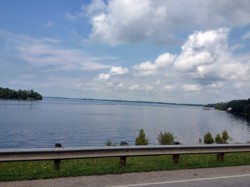Hartwell Lake in Drought Trigger Level 1
 Lakes Hartwell, Russell and J. Strom Thurmond are now in drought trigger level one.
Lakes Hartwell, Russell and J. Strom Thurmond are now in drought trigger level one.
The three reservoirs on the Savannah River operated by the U.S. Army Corps of Engineers entered the first drought level Monday morning, according to Corps spokesman Billy Birdwell, when pool elevation at J. Strom Thurmond Lake dipped briefly to 325.85 feet above mean sea level.
Birdwell said entering Trigger Level 1 activates the Corps’ drought management plan, which limits the discharge rate from the Thurmond Dam.
He said the final determination came Monday when reservoir levels dipped below normal.
“We had actually kissed it a couple of times already, but we did more than kiss it today, we hugged it today as well,” said Birdwell Monday. “We are in Drought Level 1. Now the reservoir went back up above that level, but once we declare, it must go two feet above it before we come out.”
The Corps said pool elevation on Hartwell Lake Monday was 656.3 feet above mean sea level. Level 1 is below 656 feet above mean sea level for Hartwell and 326 feet above mean sea level for Thurmond.
Under the existing drought plan, the Corps will now limit outflow from Thurmond Dam to 4,200 cubic feet per second, averaged over the week.
Reducing outflow decreases the amount of hydropower generated through the dams but conserves more water in the reservoirs. In addition, the 28-day average flow of the Broad River into Thurmond Lake is 18 percent of normal.
Because of these conditions, the drought plan limits outflows from Thurmond Dam and water managers will begin a systematic reduction in outflows and will reach 4,200 cubic feet per second later in the week.
For the public using the lake, Birdwell said it means taking some extra safety precautions while on the lake.
“Anytime that people are in a boat or a personal watercraft, they need to particularly be careful because obstructions that are under the water are now closer to the surface because the surface has gone lower,” said Birdwell. “That puts underwater rocks and sandbars and tree stumps and stuff closer to the surface, so they need to be very careful. They need to pay close attention to what they are doing.”
Also, dock owners may need to move their docks to remain in adequately deep water.
Birdwell said that it is not unusual this time of year to go into Drought Trigger Level 1 and he says the lakes could stay in level 1 for some time.
“We expect to stay at Drought Level 1 for a while,” said Birdwell. “It is not looking as though we are going into a severe drought pattern at the moment. The extended forecast for the upper basin is about equal chance of being normal or a little below normal. This is the time of year we are traditionally low on rain. We certainly in the next few weeks that the reservoirs will continue to decline slowly.”
Water managers and dam operators reduced outflows from the Thurmond Dam earlier in the month and relied on increased pump back operations at Russell Dam to retain water in the three-reservoir system.
Pump-back allows the Corps to generate electricity at the Russell Dam during peak afternoon demand times then reverse turbine direction at night to return the water for reuse the next day, providing power even during drought.
